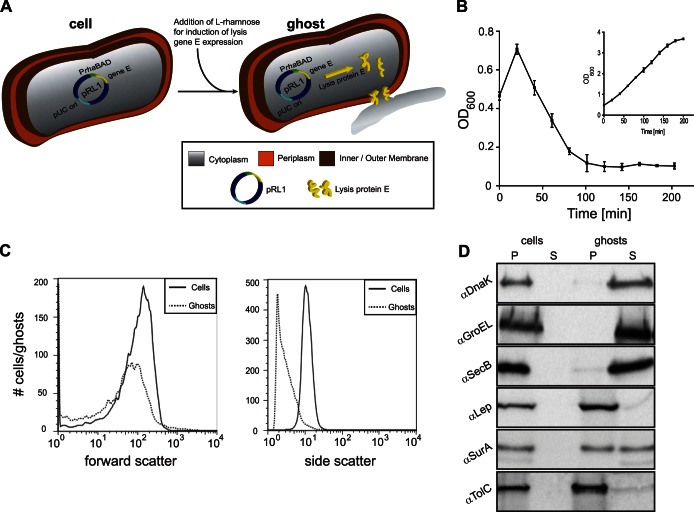FIG 1.
E. coli ghost formation by rhaBAD promoter-governed expression of lysis gene E. (A) Schematic representation of an E. coli cell harboring the rhaBAD promoter-based lysis gene E expression vector pRL1. Expression of lysis gene E is induced upon the addition of l-rhamnose. The production of lysis protein E leads to the formation of tunnel structures spanning the entire cell envelope. Through these tunnel structures, the cytoplasmic content of the bacteria is released due to osmotic pressure. (B) E. coli MC4100 cells harboring pRL1 were cultured in LB medium at 30°C. Expression of lysis gene E was induced with 6 mM l-rhamnose during mid-log phase (time = 0 min). The optical density (OD600) of the culture was monitored at the indicated time points during a period of time of 200 min after addition of l-rhamnose. The inset represents a culture of MC4100 cells harboring pRL1 to which no l-rhamnose was added. Error bars indicate ± standard deviations (SD); n = 3. (C) Using flow cytometry, cell and ghost sizes (forward scatter) and granularity (side scatter) were monitored. Straight lines, cells; dotted lines, ghosts. (D) Control cells, ghosts, and the culture medium were analyzed for the presence of a set of cytoplasmic (DnaK, GroEL, and SecB), periplasmic (SurA), and inner membrane protein (Lep) and outer membrane protein (TolC) markers by means of SDS-PAGE/immunoblotting as described in Materials and Methods. P, pellet; S, supernatant. For DNA localization as a marker for ghost formation, see Fig. S1 in the supplemental material.

